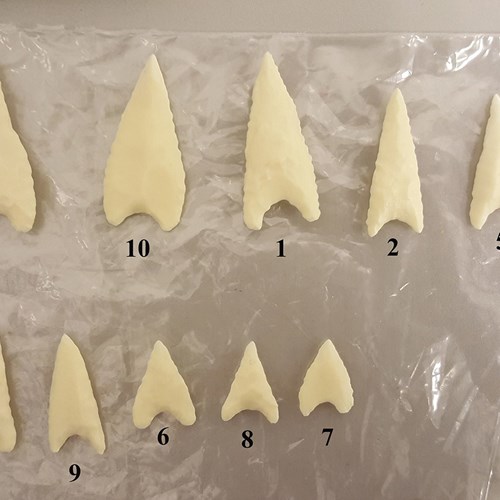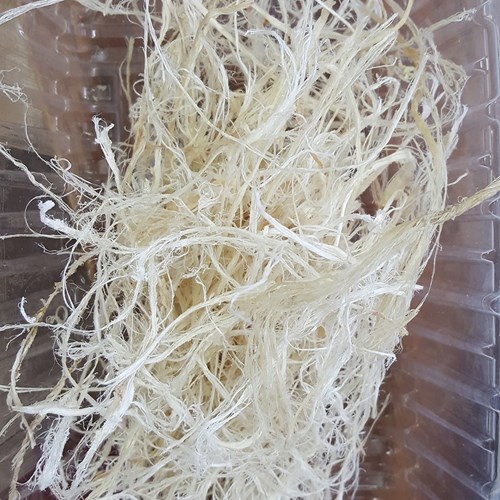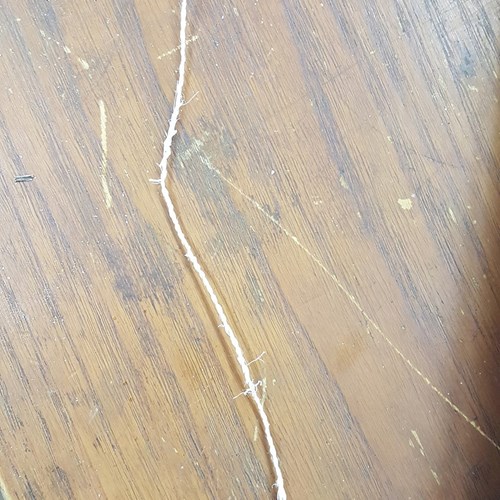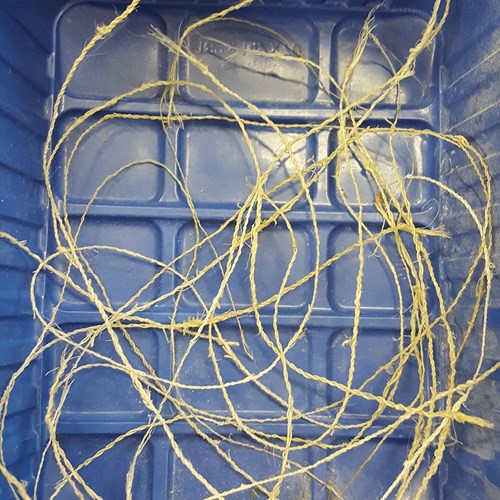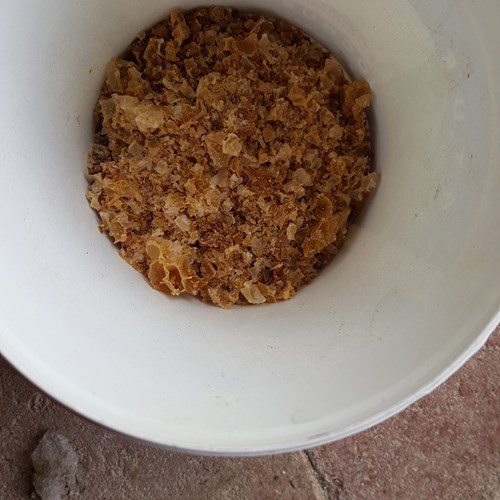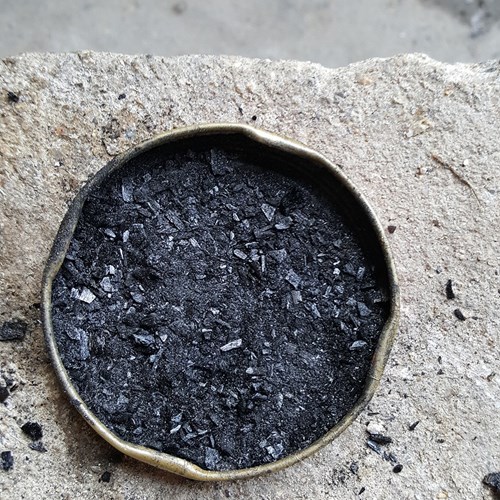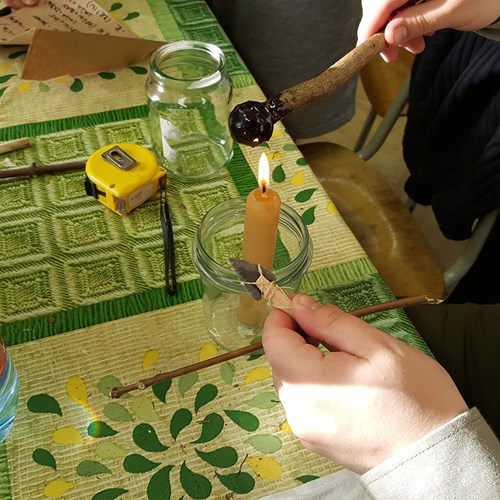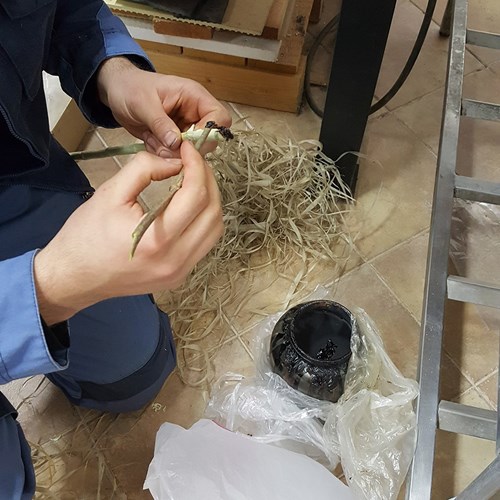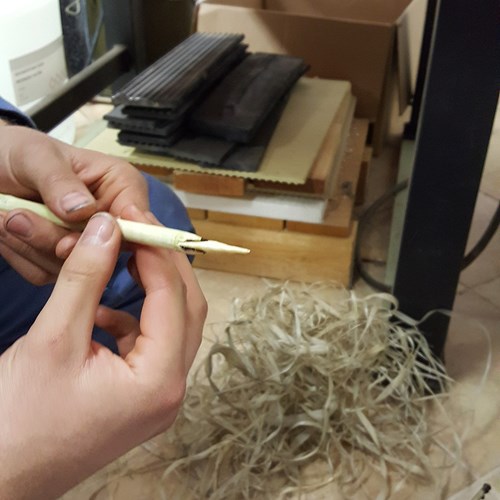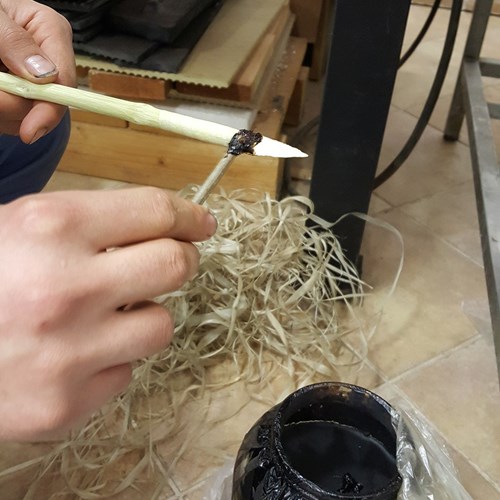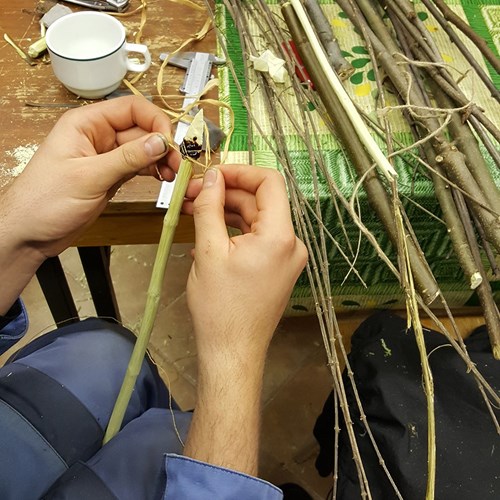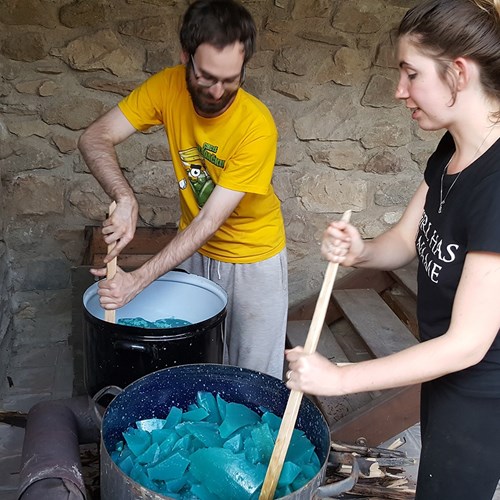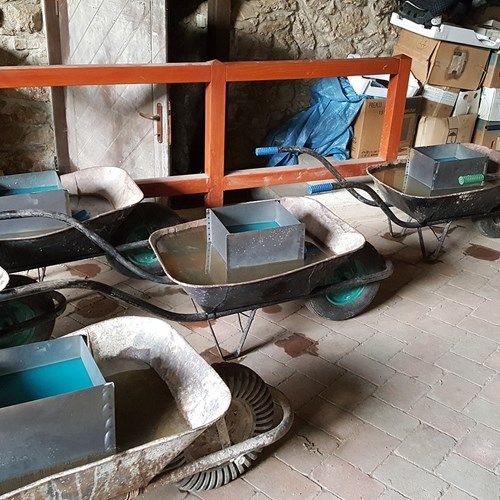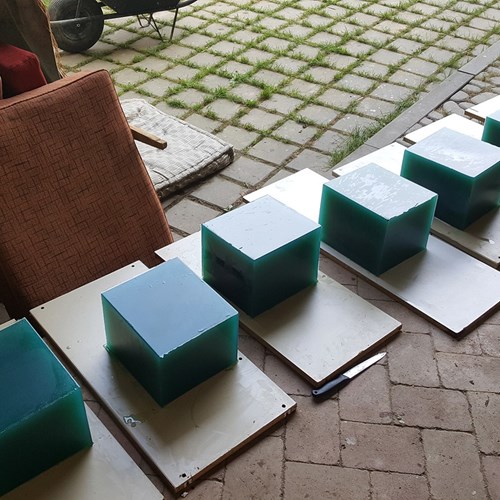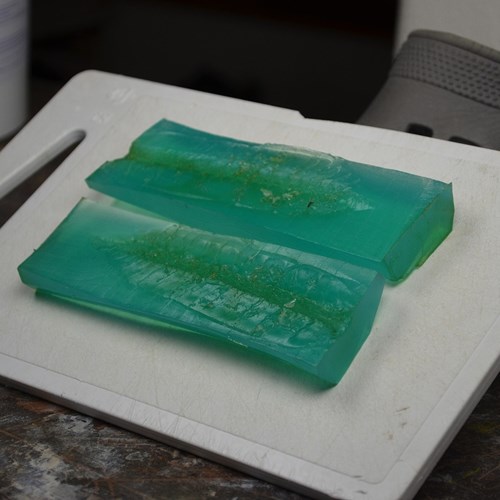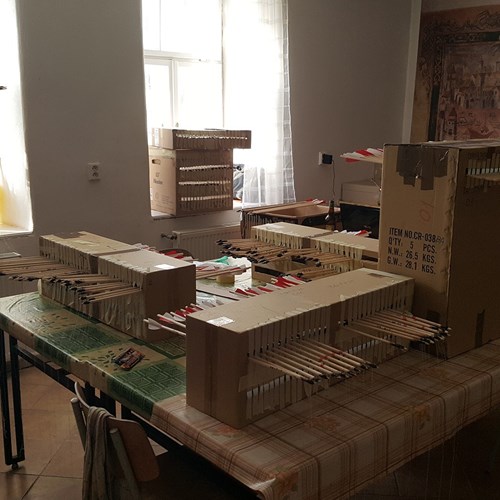Experimental testing of External and Terminal Ballistics of Early Bronze Age Lithic Arrowheads
Team
- Ludmila Kaňáková – EBA projectile research, experiment project, logistic, funds
- Jana Mazáčková – practical archery tutorials, shooting
- Vojtěch Nosek – target measurement, 2D, 3D documentation and computing
- Petr Huta – velocity measurement and analysis
Participants
- Jan Havelka – shooting
- Petr Žaža and Anna Nováčková – gel target recycling and logistics
- Ondrej Bobula – 3D assistent, logistics
- Ondřej Pelikán – video and photo documentation
- Lukáš Hetmánek – logistics
Arrow Completion
- Jan Havelka
- Jakub Havlíček
- Ondrej Bobula
- Andrej Púčať
- Michal Trávníček
Experiment preparation
The goal of the experiment was to prove warrior function of Nitra culture projectiles. It is based on different ballistics goal in hunting and in war conflict. Designing of lithic projectiles is tied with their specific behaviour in external and terminal ballistics.
The material included epoxy casts of the original lithic projectiles, standardised shafts, material for hafting and gluing the points to shafts and all necessary targets. The documentation involved a set of two high-speed cameras, 3D photogrammetry, audiovisual and photographic documentation.
Based on my research of Nitra culture projectiles, I defined ten ballistic types, which were replicated by casting method. The casts of individual projectiles were made on the basis of accurate 3D data acquired by the 3D photogrammetric method, which proved to be far more accurate than the available 3D scanning (Nosek–Kaňáková, in print). We tested large, medium and small projectiles, with high or flat cross section, with flat or rhombic tip and both cross-sectionally symmetric, and asymmetric.
Their 3D digital models were made with the help of the 3D photogrammetric method, using the Structure from Motion (SfM) procedure. The images of individual projectiles were captured with a stationary digital reflex Nikon D5100 camera (resolution 16.2 Mpx), and a Nikkor 60 mm f/2.8 G ED AF-S Micro lens. The aim was to create virtual copies of artefacts that were as accurate as possible and which could subsequently be used as templates for 3D casts of ballistic test samples. The temporal and technical demands of the calculation and modification of data were absolutely subordinated to this primary task. All images were processed using Agisoft Photoscan Pro software, which provides a satisfactory result regarding the accuracy and resolution of the final 3D models. We applied the same working method that we developed during the processing of samples in the case study on lithic projectiles from the site of Hroznová Lhota (Kaňáková–Nosek, in print).
The accurate 3D data were handed over to the M-CAE system company, which provided for their replication, which was necessary for evident reasons. The original archaeological relics cannot be used and the crafted chipped-stone copies would only be approximative due to the individual characteristics of lithic raw material. For an experiment on ballistic qualities, however, the 100% accordance is of key importance, because particular asymmetries and curvatures of profiles and cross-sections represent the examined parameter. 3D replicas in a quality and size corresponding to 100% of the dimensions and complexity of surface in individual projectiles are only possible with the technique of liquid polymer casting. From these absolutely accurate type studies we already can make faithful copies using a more common and therefore also cheaper epoxy casting method. Making all 250 copies with an ultra-accurate technology would be financially unrealistic. The ordinary 3D ABS print technique is not suitable for scientific experiments due to its small resolution and coarse contours.
The only disadvantage of epoxy casts, one that cannot be eliminated, is the fact that the raw material used does not reach the same density as the original stone, which means that the epoxy casts are somewhat lighter than the original lithic projectiles. Moreover, stone materials differ from each other in density (i.e., in the weight of products depending on their volume) not only by individual stone types but also by individual pieces of these raw materials. The density of original raw materials in individual projectiles would thus never be the same as the density of casts, even though their shape and weight are identical. When we compare the weight of original projectiles, which range from 0.21 to 3.9 grams, with the total weight of a complete arrow, which varies between 15.5 and 21.9 grams, we regard this fact as insignificant. Epoxy casts reach up to c. 51–71 % of the weight of their original individuals, depending on the raw material type. Even though standardised shafts are used, the total weight of an arrow is also affected by the weight of hafting and gluing material, which is sometimes heavier than the entire lithic projectile. Therefore, we regard this difference between the weight of originals and copies, ranging from 0.15 to 1.13 grams, as insignificant. The highest possible deviation of impact energy in velocity of 30 m/s caused by this difference in weight is about 0,5 Joule.
Polyjet 3D print technology and the acquired data were applied to produce one authentic copy for each ballistic type. These replicas were sealed in a silicon matrix. All 10 ballistic types were based on the same inlet system, which made production as cost efficient as possible. The mould was subsequently cut in halves and the 3D copies were removed, which created the casting matrix. The hollow matrix was then filled with resin in a vacuum casting chamber. Using the vacuum casting chamber technology eliminates the emergence of air bubbles and ensures the complete mass homogeneity of the cast. Simple gravitational casting was applied and three casting substances were tested. The first test involved the F160 resin with RZ30150 sand in a proportion of 100:100, which proved to be unsuitable due to very low weight and a high deviation from the weight of the original lithic artefacts. Subsequently, the polyurethane PX245L casting substance with a glass admixture was tested. However, this was too light (49% on average) and, moreover, made a haptic impression of plasticity. In the last version we again used the F160 resin with RZ30150 sand in the maximum possible proportion of 100:180, which on average reached up to 63% of the weight of the original lithic projectiles and was realised during the entire service life of the matrix. By this way, 25 identical casts of each ballistic type were acquired. We used 10 of them in every type set for basic statistics of flight and wounding qualities, where the shooting was done with the same bow, by the same archer, at the same distance and with a standardised gel target. Second half of them (06-10 items of every set) were hafted in shafts with front slot perpendicular to the nock, which is a modification that slightly improves speed. Another six projectiles from each set were used for other experimental variants of target covering. Three items were used for other experimental variants of distance. These projectiles were set in shafts with the identical direction of both slots. Three projectiles from each set were intended for a detailed study of terminal ballistics, with targets made of clay blocks. Two specimens from each set were given to both of the participating archers to get some practice with these specific projectiles for aimed shooting before the experiment. At the same time, they were asked to assess the difficulties of shooting within a certain weight range of the tested ballistic types with the same bow. The last specimen from each set was set aside as a reference and comparative piece.
Fig. 01: Epoxy casts of Nitra culture projectiles.
Although the content of Ötzi’s quiver (Egg–Spindler 1995, 39–50) probably makes us assume the use of shafts from suitable pieces of rods, for example from hazel or guelder-rose (viburnum), for the purpose of measuring the exact experimental ballistic data we chose standardised shafts split off a single tree trunk. The reason for this is the fact that every single twig or rod of guelder-rose, dogwood, hazel or another similar bush tree also has its individual physical properties, above all specific elasticity, maturity and hardness in relation to the cross-section and weight of the shaft, which would generate undesirable differences between individual shots. These differences might disturb the study of ballistic differences in individual types of projectiles. For the needs of a statistic evaluation of projectiles, it is necessary to standardise to the greatest possible extent the other input parameters of the experiment. For this reason, we chose shafts split off a single spruce trunk, where we can suppose a higher grade of unification in the input parameters of shafts. Even though spruce shafts are not authentic, they enable a better examination of the ballistic differences between individual types of projectiles, because shafts from a single piece of wood show a standardised behaviour in these parameters. Mock shooting with training casts eliminated the shafts from pine or fir, because they were too heavy and stiff for such light projectiles, although within the overall spectrum of wood species used for this purpose, these woods are generally classified among the light and flexible ones. This is why spruce shafts were chosen, 29 inches long, 5/16 inch in diameter, and with a spine of 35 to 40 pounds. Also standardised was the fletching with three fins attached straight to the shaft. The weight of shafts is 15 g, with a deviation tolerance of 2 grams. The shafts, including the indicated front slot and self nock, were delivered by the Lazecký company. The indication of both slots on the shaft was chosen in order to eliminate the risk of springing the shaft during the preparation of slots with traditional prehistoric tools. The front slot was individually modified by hand to fit the shape and width of the base of individual projectiles, and the nock was expanded to fit the width of the bowstring. Stone tools used for the final trimming of shafts were made from erratic flint. A total of 170 shafts were prepared with both slots oriented in the same direction, and 50 shafts were made with the front slot perpendicular to the nock.
For hafting projectiles, we chose a variant that involves both binding and gluing. The material used for binding and gluing is marked out on each shaft. Binding was accomplished with the help of thin cords twisted from two fibres of animal sinew, lime bast or nettle fibres. Twisting was inevitable, because we were unable to acquire sufficiently long animal sinews. The cooperation with breeders or veterinary laboratories is not yet developed in the Czech Republic. We acquired the limbs of six freshly slaughtered adult goats, but the ligaments were already damaged before delivery. The longest piece of prepared sinew was 19 cm long, whereas the tight binding of a projectile to the shaft required fibres at least 40 cm long. When a cord is made by twisting, it is easy to extend the product by another strand and so we provided for a sufficient amount of binding material. In the case of lime bast or nettle fibres, individual strands used for a binding were susceptible to tearing or cutting by the arrowhead’s edge. The twisting of two thin strands eliminated these negatives even in thin cords, so that it was possible to tighten them to a sufficient strength. The thickness of produced cords did not exceed 0.75 mm, but they were usually thinner.
Fig. 02-04: Hafting material of experiment.
Gluing was tested with three different adhesives. Resin collected in the forest and melted in a tin on embers crumbled when used. The addition of 10-20% beeswax (recently successfully tested by Coppe–Rots 2017, 114 – mixture 70:30) did not produce an entirely homogeneous gluing substance. We took the substance out from the tin and wound it on sticks, which we then warmed above a burning candle when gluing a projectile to the shaft. In most cases, however, the wax exuded on the surface of the gluing substance, which subsequently again created brittle crumbles, in the same way as with the resin itself. A somewhat better result was achieved by mixing 90% resin and 10% lard mixed with crushed cinders. The preparation of the sticks was much easier, but the substance warmed above the candle solidified very quickly when taken away from the fire. The best results were achieved using tar acquired from a pinewood charcoal kiln. A sufficient amount of tar was provided to us by the Technical Museum in Brno, which regularly organises re-enactments of charcoal burning in medieval kilns. The tar was acquired from a charcoal kiln in May 2017 in entirely liquid form. Until the time of use in January 2018, ethereal components partly leaked out, so that the consistency had an ideal plasticity. Already in November, we tested the hafting of a projectile to the shaft and let the glue mature in a heated room. An inspection after two months proved the perfect hardening of the substance. The plasticity of the adhesive was very beneficial to our work, as it made it possible to leisurely smooth down any bumps and drops and remove all excess substance which would otherwise diminish the aerodynamic qualities of the arrow. Each completed arrow was weighed. We used three possible glues to observe whether they (the hardness of connection) caused any differences in terminal ballistics – in projectile releasing. However, no differences were observed.
Fig. 05-13: Gluing and binding of projectiles.
Targets for individual phases of the experiment differed by the examined parameters. In phase A, where the ballistic qualities were tested in statistic series, gel targets were used. Doubling mass Gelodouble, produced by the Interdent company, is an agar duplicating material of Shore A20 hardness, which is up to 20 times thermally reversible. It suits the requirements of the experiments better than edible gelatine, whose low melting point around 8 °C considerably limits the realisation of the experiment to short periods of the year. These periods, moreover, are not very convenient for archers, because it is not possible to keep any larger numbers of targets without a cooling device. The holding capacity of refrigerators, considering the necessary dimensions of targets for aimed shooting, is of course limited when we intend to accomplish shots into 160 gel blocks. The size of targets can only be reduced by using a mechanical, steadily-aimed bow (e.g., Waguespack et al. 2009; Wilkins et al. 2014). The dispersion, and therefore the necessary size of the front target area is larger with aimed shooting. The usually applied ballistic gel cannot be bought in the Czech Republic, and military institutions have only limited reserves for their own use. All of the three gel substances exhibit approximately the same stiffness and density, which acceptably simulates the living tissues of mammals (Juříček 2013, 81–82). Nevertheless, the naturalistic imitation of shooting into a living body was not the goal of the experiment. Such realistic accuracy cannot be achieved with any of the available materials, not to mention e.g., a pork carcass, since dead flesh shows a different reactivity than the living body. Although gel materials do not react in completely the same way as animal tissues (Karger et al 1998), they enable a mutual comparison of the effectiveness of individual functional types (Salem–Churchill 2016). The aim of the experiment is to use a sufficient statistical sample to observe the impact of the specific design of projectiles on their ballistic qualities, to acquire a set of mutually comparable data enabling the examination of the ballistic differences connected with a specific design of projectile. Therefore, when shooting was conducted under the same conditions (distance, bow, archer and target material), the results are objective. The Gelodouble duplicating material is considered by us suitable with regard to processing demands, reversibility and price. The substance is shaped by warming it to 93 °C and cooling to 45 °C, after which it is prepared to be cast into a target block. After documentation of the shot, it can be cut into pieces and melted again to be cast into another block. The gel density is 1,220 kg/m3, which corresponds to the average density of human tissue at 1,100 kg/m3, within an interval from the density of blood at 1,054 kg/m3 to the density of bones at 1,650 kg/m3 (Juříček 2013, 81). Casting moulds were made from 0.2 stainless steel sheet in the form of a cube with a 28.5 cm edge, which offered a compromise between adequate size on the one hand and acceptable handling regarding the weight of the gel on the other. The width of the target area approximately corresponds to the width of the chest of an adult man and, at the same time, to the minimal front size of a target necessary for the elimination of unsuccessful shots even from a large distance. The depth of the target approximately corresponds to the depth of the chest of an adult man from the studied Early Bronze Age population, with some reserve in order to avoid penetration of the projectile through to the other side, which would affect the accuracy of measuring the penetration depth and number of rotations. A gel block with these minimum dimensions weighs c. 25 kg, which is a boundary value for acceptable handling.
Fig. 14-16: Gel targets processing.
After cooling down, the blocks were tipped out onto wooden boards and transported by two assistants first into the shooting position and subsequently to the 3D documentation post in order to secure both a fluent course of the experiment and the highest possible intactness of the emerged wound until the moment of documentation. Insensitive handling, even during the short transport between individual positions, would cause a large extension of shot fissures or even the disintegration of the whole block. The entry crack was measured immediately after the shot, even before the block was transported to the documentation post. Jute sacks with wood chips were placed behind the target and two safety screens were positioned at a distance of 2 metres.
More detailed recording of characteristics of the wound track was made with targets from clay blocks. The aim was to acquire a better documentable negative of the wound channel and more information about the impact of rotation on the extent of the wound tract and tissue destruction. Ceramic clay is a material with a roughly two times higher density (2,517 kg/m3), and the character of friction and resistance of material towards the energy of arrow also are different. Nevertheless, it is used in ballistics especially for the study of the wound track (Juříček 2013, 91). Even though there is a difference in penetration depth and the number of rotations after contact, the character of the wound track enables more accurate spin documentation and progress in work for the future model of wounding capability based on three main measurable variables, i.e., the total area of a projectile, the number of after-contact rotations and penetration depth. The ballistic potential of cross-sectionally asymmetrical projectiles is increased by higher resistance of the environment, the deflections from the straight direction and the tendency to rotation are more distinct.
We used large jute sacks filled with wood chips for shooting into a more distant target with the goal to measure impact velocity changes in different distances. We needed targets of sufficient size for aimed shooting for 10 and 14 meters.
The targets were positioned on a solid stand at a height of 105 cm (the height of the target ranged from 105 to 135 cm), which satisfied the needs of the archer with regard to his body height and at the same time corresponded to the central thoracic height of an upright standing man of the Nitra culture (between the lower ribs and collarbones).
Two primitive archers were involved to the experiment. The goal, besides the logistics, was to observe possible impact of archers individuality. Their shooting was compared independently. Their tasks were separated to eliminate the impact of shooting style to results compared one with each other. Our archers physical parameters are in accordance with our knowledge regarding Nitra culture archers. Archer A, a woman of athletic somatotype (168 cm, 51 kg) and archer B, a man of lighter athletic somatotype (175 cm, 64 kg). Archers in the Nitra culture were always men, mostly in the age of AD II to MAT I. The sparse metric data published to this day (Hanulík 1970, 335; Dočkalová 2006, 52; Šefčáková 2014, 308) indicates that adult men of the Nitra culture rather were mid-shouldered, 160 to 170 cm tall, and only exceptionally more robust with a height of up to 180 cm. Our two archers are of a rather medium-tall and slender build, which corresponds to the population of the Nitra culture.
Two bows were used during experiment. The archers used both, again in strictly separated tasks, with the goal to specify closely parameters of original Nitra bows, and observe in detail impact of archer and bow to the results. The parameters of bows per se are of marginal importance because we do not know the appearance of the original Early Bronze Age bows in Central Europe. The absolute measurable values with which we are working include the initial and the impact energy of the projectile. The parameters are thus only given as a clue for other experimenters. The qualities of a bow, above all its draw weight, are rather important to the archer himself. The bow length is a parameter partly based on the stature of people who used the bow, but also on the character of the environment in which they were mostly active. The chronologically and geographically nearest find of a preserved bow, together with the documented body height of its user, is probably represented by the bow from Similaun (3350–3100 BC, Egg–Spindler 1995, 33). Ötzi was c. 160 cm tall and his bow measured 182.5 cm (Egg–Spindler 1995, 27 or 37 respectively). Setting aside the fact that the bow was not completely finished, the natural environment and the landscape differ considerably from the Central European ecumene of the Nitra culture. It was a passage through an unforested alpine area, where the bow was also used as climbing support and its wearing was not hindered by any high-growing vegetation. Men of the Nitra culture, on the other hand, mostly moved about a landscape with flatlands and moderate hills covered for the most part with bushy and forest vegetation (Hajnalová 2012, 88), where it would be relatively inappropriate to wear a bow longer than the body height of the people themselves. From the Bronze Age we know at least three wooden bows which are long enough to identify their total length – Cambridge-Fens 153 cm (Junkmanns 2013, 317), De Zilk 160 cm (Junkmanns 2013, 318), Lötschenpass-3 166 cm (Junkmanns 2013, 312–313) and Barleben 152 cm (Junkmanns 2013, 305), respectively. The preserved Early Bronze Age bows are thus generally shorter; three specimens come from flatlands, and the longest one comes from an alpine environment. Therefore, we can say that the bows utilised in our experiments are also consistent with the original period of their use. The analysis of wounding capability was carried out with bow X. The crucial parameter of a bow is its draw weight, which together with the arrow weight defines the kinetic energy of a projectile. The draw weight of a bow, projectile weight and spine of the shaft must be balanced together in order to avoid breakage of the shaft or the nock, the low efficiency of the flying range, the inaccuracy of arrows and other undesirable effects. For this reason, we tested bows with different draw weights, which, nevertheless, were generally lighter with regard to the weight of the original projectiles.
|
|
Construction |
Draw-weight |
Archer A draw-length (maximal/median) |
Archer B draw-length (maximal/median) |
|
bow X |
fibreglass-wood |
35 lb |
60/58,2 cm |
64,5/62,1 cm |
|
bow Y |
ash wood |
55 lb |
58/55,9 cm |
62,4/59,5 cm |
Table 01: Used bows parameters.
We documented every single shot by a set of two high-speed cameras of the SIMI motion system for 3D cinematic analysis, with recording frequency of 500 KHz. Initial and impact velocity were measured and impact energy computed, as every arrow was weighed before. We shot projectiles in sets to limit the risk of value deviations, which were common in all earlier published experiments, including those conducted with mechanic bow or cross-bow, i.e. excluding personal impact of archer performance. The recording system was installed from two directions so that one of the cameras recorded the target perpendicular to the shooting direction and the other slantwise to the shooting direction. The average initial velocity of an arrow shot by archer A from both bows was determined on the basis of three measurements for each bow. Immediately after each shot, we measured the entry crack and marked the penetration depth on the shaft.
We used 3D and 2D documentation of wounding trace both with gel, and with clay targets. It is important to understand, the penetration depth is not only important parameter of wounding. It is important to reconstruct permanent and temporal wounding canal and details of energy loss. We observed number of revolutions, tendency to cause perpendicular cracks – the radial fissures and width of the entering fissure. The whole procedure consisted of several phases, and the documentation and evaluation processes were most complex when shooting into gel targets. Since the method is technically innovative and any similar procedure has not yet been published, it is described in detail below.
Due to the fact that we shot three arrows into the same standardised target during the experiment because of time constraints, it was necessary to find out how and whether the character and dimensions of the wound changed with the next shot. The impact of the second projectile shot might influence the spatial qualities of the first examined injury. In the first phase (before the disassembly of the gel block), we chose the entry wound on the surface of the ballistic gel as the evaluated quantity. It was manifested as a linear crack of varying length, with the body of the arrow stuck approximately in the middle. The length of the crack was recorded within c. 10 seconds after the hit, subsequently again after the next projectile shots, and for the third time after transport of the target to the documentation post (Fig. 3). As expected, the gel often reacted to the impact energy of the next shots and to the subsequent transport by even a multiple expansion of the entry crack. The difference between the initial size of the wound and its expansion after the next shots and transport are illustrated in the following table (Tab. 3).
|
Ballistic type |
Entering fissure median intact (cm) |
Entering fissure median after other impact (cm) |
|
01 |
4 |
6.8 |
|
02 |
2.8 |
8.3 |
|
03 |
2.8 |
8.8 |
|
04 |
2.2 |
4.7 |
|
05 |
2.5 |
6.3 |
|
06 |
2.5 |
8.4 |
|
07 |
2.9 |
9.2 |
|
08 |
1.7 |
5.2 |
|
09 |
2.1 |
7.8 |
|
10 |
2.8 |
6.8 |
Table 02: Development of entering fissure after external impact.
However, we empirically detected, the shape memory of the gel shows in very clear way different traces of permanent canal, temporal canal and secondary impact caused by handling.
We measured impact angle with the goal observe variability in external ballistics of arrows tipped by different projectiles. The deviation was measured on angular scale in two axes. Depth of penetration was measured in this step of documentation.
The following step consisted in documenting the mutual positions and relationships between individual arrows shot into the same target for the purpose of an overview and possible further considerations. This was followed by the factual division of the target into three separately evaluated blocks, each containing an individual arrow. Parallel to the impact axis of the arrow, a block of gel was cut out for further documentation. Target block was carefully cut off and wounding trace was documented with intense contre-jour lighting. It makes visible details of wounding trace. Arrow was moved consequently, and wounding trace documented again. The third phase of this documentation step was realised with filling in the wounding canal by contrast liquid, which showed both lacerations along the impact axis, and perpendicular cracks. All features of wound, normally neglected or invisible in experiments, was visible and documentable.
Fig. 17-19: Wounding canal documentation.
Thinned gel block, documented before, was carefully split along the longitudinal axis. It gave us two halves of wounding trace, which were further documented in 2D and 3D. Comparison of both halves verify the results – measured values.
For the documentation of the real extension of the wound track we used, among others, the 3D photogrammetry method. For each relevant section we took a series of several images, which were subsequently evaluated in the Agisoft Photoscan Pro software and used for calculating the volume of the permanent and temporary cavity, calculating the model of the wound relief, etc. Although we obtained 3D data, optical properties of the gel, the transparency and homogeneous texture, represented serious obstacle for obtaining of an sufficient number of points for further 3D analysis. An overlay with an adhesive contrast medium, e.g., chalk dust, which is commonly used with transparent or reflex surfaces, was not possible, because the ballistic gel was continuously recycled for other targets and its contamination was out of the question. We used other kind of documented data to calculate wound volume. It is based on digital measurement of longitudinal profile area. By this kind of documentation we are able to preserve otherwise unpreservable data on the character of a shot wound.
This documentation process was also used with the documentation of gel targets with an overlay. After the documentation was finished, the surface of both halves of the wound inside the gel segment was examined in detail with a 10x magnifier and the occurrence of overlay particles most distant from the entry crack was recorded.
Wounding canal was documented in clay targets too, although with different goal. Regarding clay plasticity,
the entry hole did not create any crack in the width axis of the projectile at the moment the arrow entered the target, but maintained the shape and orientation of the Total Cross-section Area (ToCSA) of the projectile at the point of contact. We define ToCSA as the total area (2D) of the entry wound. It is significantly more precise value in terminal ballistics, than Tip cross sectional area used earlier. ToCSA is a projection of all cross-sections of a projectile from the tip to the barbs, and not only as a simple cross-section in the widest place. We carefully cut the target along impact axis to reveal the shape of the wound, especially traces of projectile revolution caused by their cross-sectional asymmetry. Rotation traces in gel were indicated by longitudinal fissures only, but they were exhibited clearly as evident rotation marks in clay. Each “curl” in the trace presented one revolution, i.e. 180°. Number of “curls” was compared in both halves of target.
Implementation
Experiment was divided into two basic phases. Their sub-phase order were conducted in dependence of all logistic circumstances, for example long periods of gel targets congealing. Our experiment costed five days from early morning to midnight including two days of target coiling tests and facilities preparation.
Phase A goals were mainly to test how ballistic design and cross-sectional asymmetries influence external ballistics, after contact trajectory, impact energy (velocity) and wounding capability.
The shape and extent of the wound, the difference between distinct projectile types was examined using a combination of 3D documentation and mathematic calculations based on the total area of both cavities in longitudinal cut, penetration depth and the number of after-contact rotations.
Phase A1 included 100 shots to the gel targets in total, ten arrows of each ballistic type, for 8 meters of distance. Ten results for the same projectile creates sufficient sample of data – starting velocity, impact velocity – i.e. impact energy, penetration depth, permanent and temporal wounding canal volume, number of revolutions during the flight and after the contact. One half of arrows in set was manufactured with perpendicular position of nock, which is feature giving initial spin impulse.
Phase A2 included 60 shots to the gel with overlay in total, six arrows of each ballistic type, for 8 meters of distance. The effectivity of projectiles against clothing or defence barriers (linen canvas, tanned goat leather, gambeson) was tested. Effectivity of projectiles in insertion of small particles of cover into the wound was measured too. Changes in wounding capability was compared with results of phase A1. It takes more data of impact velocity in 8 meters.
Phase A3 included 30 shots to clay targets in total, three arrows of each ballistic type, for 8 meters of distance. Details of penetration trajectory and rotation was observed. It takes more data of impact velocity in 8 meters.
All three parts of phase A were shot by bow X, phases A1 and A2 by archer A, and phase A3 by archer B. It gave us data for comparison of archer performance with the same bow (impact energy in 8 meters).
Phase B was focused mainly to external ballistics. It include 70 shots to wood chips sack in total, for 8, 10 and 14 meters. Results of both archers with both bows were compared. The measured penetration depth is important only for a mutual comparison of individual sets; it does not include any absolute informational value. The form of wound is not documented in this phase because wood chips do not enable this; the arrows could be used multiple times.
|
Phase |
Target |
Distance |
Shaft type |
Archer/bow |
Number of shots |
Series of projectiles |
Goals |
|
Phase A1 |
gel target |
8 metres |
parallel notches |
archer A, bow X |
10 types x 5 shots |
series 01–05 |
- impact energy - wound volume - penetration depth - number of rotations |
|
Phase A1 |
gel target |
8 metres |
perpendicular notches |
archer A, bow X |
10 types x 5 shots |
series 06–10 |
- impact energy - wound volume - penetration depth - number of rotations |
|
Phase A2 |
gel target covered by linen textile |
8 metres |
parallel notches |
archer A, bow X |
10 types x 2 shots |
series 11–12 |
- wound volume - penetration depth - cover particles injection |
|
Phase A2 |
gel target covered by gambeson |
8 metres |
parallel notches |
archer A, bow X |
10 types x 2 shots |
series 13–14 |
- wound volume - penetration depth - cover particles injection |
|
Phase A3 |
clay target |
8 metres |
parallel notches |
archer B, bow X |
10 types x 3 shots |
series 15–17 |
- wound morphology - after contact rotation effect - impact energy difference by the same bow but a different archer – comparison archer A and B with bow X |
|
Phase A2 |
gel target covered by tanned goat leather |
8 metres |
parallel notches |
archer A, bow X |
10 types x 2 shots |
series 18–19 |
- wound volume - penetration depth - cover particles injection |
|
Phase B |
sack with wood chips |
8 metres |
parallel notches |
archer A, bow X |
10 types x 1 shot |
series 20 |
impact energy difference between X a Y bow - reference shooting between gel and wood chip target |
|
Phase B |
sack with wood chips |
8 metres |
parallel notches |
archer B, bow Y |
10 types x 1 shot |
series 20 again |
impact energy difference between X and Y bow |
|
Phase B |
sack with wood chips |
10 metres |
parallel notches |
archer A, bow X |
10 types x 1 shot |
series 21 |
- impact energy difference in 10 metres for bow X |
|
Phase B |
sack with wood chips |
10 metres |
parallel notches |
archer B, bow Y |
10 types x 1 shot |
series 21 again |
- impact energy difference in 10 metres for bow Y
|
|
Phase B |
sack with wood chips |
14 metres |
parallel notches |
archer A, bow X |
10 types x 1 shot |
series 22 |
- impact energy difference in 14 metres for bow X |
|
Phase B |
sack with wood chips |
14 metres |
parallel notches |
archer A, bow Y |
10 types x 1 soot |
series 22 again |
- impact energy difference in 14 metres for bow Y - comparison of archer A with both bows |
|
Phase B |
sack with wood chips |
14 metres |
parallel notches |
archer B, bow Y |
10 types x 1 shot |
series 22 again |
- impact energy difference in 14 metres for bow Y - comparison of archer A and B with bow Y - comparison of archer B with both bows (bow X to clay) |
Table 03. Detailed record of experiment phase parameters and goals.
Fig. 20: arrows prepared for experiment.
Results
Our results are in publication process.
Generally, we can say, our results verify warrior use of Nitra projectiles and differ clearly differentiated impact of defined ballistic types. Projectiles differ in use, in terminal ballistic, i.e. wounding, parameters.
